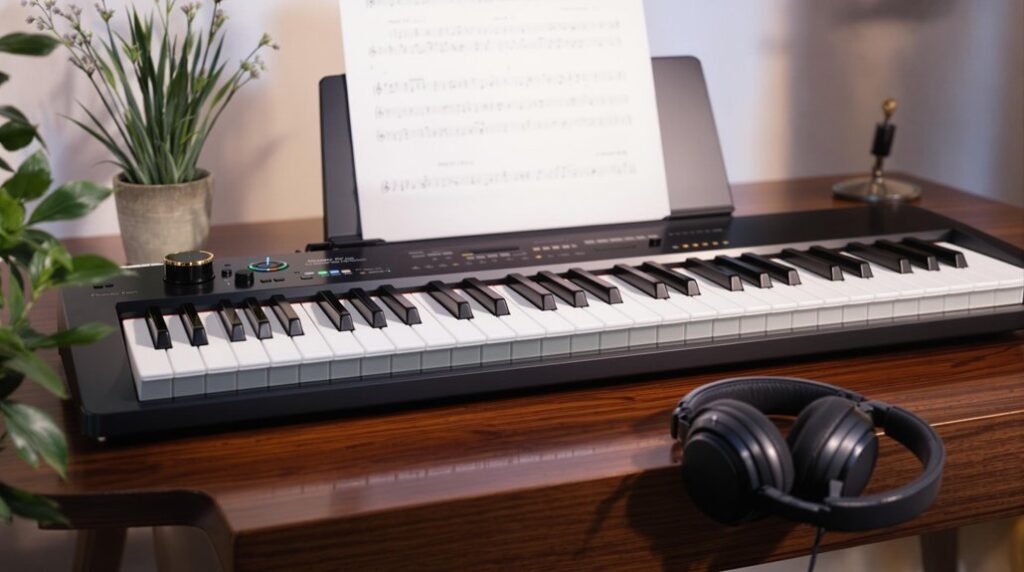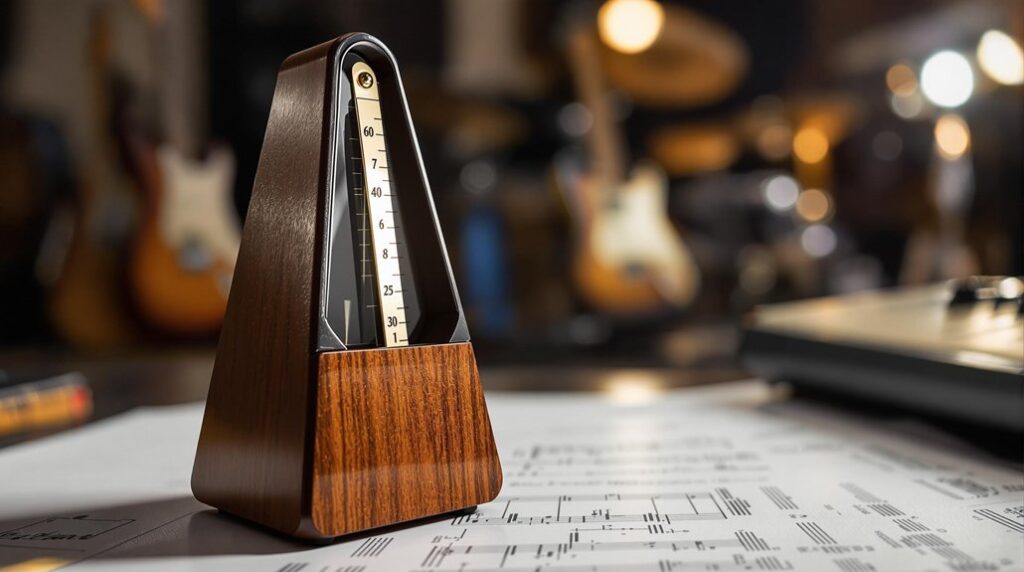Microtonality explores musical intervals smaller than a semitone, a practice that expands the harmonic and melodic frameworks beyond the 12-tone equal temperament system. Rooted in ancient Greek theory and prevalent in non-Western traditions like Arabic maqam and Indian classical music, microtonality offers nuanced consonance and dissonance. Contemporary composers such as Harry Partch and György Ligeti have pioneered custom tuning systems and instruments to explore new sonic landscapes. Advanced software tools and innovative notation enable precise representation and experimentation. By understanding microtonality, one can appreciate its profound impact on modern music composition and cultural soundscapes.
Key Takeaways
- Microtonality explores intervals smaller than a semitone, offering enhanced harmonic complexity beyond the 12-tone system.
- Historical roots include ancient Greek music theory and diverse global traditions like Arabic maqam and Indian classical music.
- Innovative microtonal techniques involve just intonation, custom-built instruments, and advanced tuning systems like 31-tone equal temperament.
- Software tools like Scala allow for experimentation with custom tuning systems and facilitate microtonal music creation.
- Microtonal music uses specialized notation systems and graphic representations to communicate complex pitch relationships effectively.
Definition and Historical Context
Microtonality, which explores musical intervals that are smaller than a semitone, greatly enhances harmonic complexity and broadens the auditory palette beyond the confines of the conventional 12-tone equal temperament (12-TET) system.
The microtonal philosophy fundamentally challenges the Western musical norm of 12-TET by introducing a broader spectrum of pitches, a concept with profound cultural significance. This is evident in the historical context, dating back to ancient Greek music theory, where theorists like Pythagoras and Aristoxenus laid foundational work in non-12-TET intervals.
In the Renaissance, explorations of tuning systems that incorporated more than 12 notes per octave—such as split sharps—demonstrated an early recognition of the limitations inherent in the 12-TET system. These historical endeavors reflect a microtonal philosophy rooted in the quest for more expressive and nuanced harmonic structures.
Culturally, microtonality has been integral to various musical traditions. Arabic maqam and Indian classical music utilize sophisticated scales and intervals that diverge markedly from Western paradigms.
The contributions of contemporary composers, such as Harry Partch and György Ligeti, have further underscored the cultural significance of microtonality. They have not only expanded the harmonic possibilities but have also explored the unique timbral qualities enabled by microtonal intervals.
Tuning Systems and Temperaments
The exploration of microtonality inevitably brings one to the examination of diverse tuning systems and temperaments, which form the structural backbone of this musical approach. Various microtonal tuning systems, such as 19-tone, 24-tone, and 31-tone equal temperament (ET), offer unique interval variations and harmonic possibilities beyond the traditional 12-tone equal temperament. These systems address tuning challenges by designing intervals that provide fresh consonance and dissonance, vital for microtonal instruments and compositions.
Historical developments in temperaments, like the meantone temperament, often resulted in anomalies such as the “wolf fifth,” illustrating the compromises inherent in tuning systems that prioritize certain intervals at the expense of others.
Enharmonic keyboards, prevalent in Italian harpsichords, facilitated the exploration of diverse triad formations and chromaticism through microtonal intervals, enriching the cultural significance of these instruments.
Understanding historical pitch standards, such as the Baroque pitch set at A=415 Hz, is essential for authentic performance practices in microtonal music. The study of microtonality reveals significant variations in consonance and harmony, underscoring the complexities and cultural implications embedded within different tuning systems.
This multifaceted approach to tuning highlights the intricate interplay between theoretical frameworks and practical applications in microtonal music.
Contemporary Composers
Contemporary composers such as Harry Partch and Rytis Mazulis have revolutionized microtonal music through the invention of new instruments and innovative compositional systems beyond the confines of 12-TET.
Influential works by Carlos Seraphini and Alois H. have expanded harmonic possibilities and redefined musical boundaries, while György Ligeti’s “Ramifications” exemplifies the creative application of microtonal intervals.
The increasing integration of microtonality by artists across various genres, including King Gizzard & The Lizard Wizard and electronic musician Aphex Twin, highlights its profound and growing impact on modern music.
Innovative Microtonal Techniques
A diverse array of contemporary composers has commenced the exploration of innovative microtonal techniques, considerably enriching the musical landscape. Harry Partch and Rytis Mazulis are notable pioneers in this field, utilizing just intonation and custom-built instruments to investigate harmonic possibilities that lie beyond the traditional 12-tone system. Their efforts underscore the importance of microtonal education in broadening the scope of musical expression and training the next generation of musicians.
Carlos Seraphini’s adoption of 31-tone equal temperament (31-ET) exemplifies the expanded melodic expressiveness and intricate harmonic relationships achievable in modern compositions. This technique allows composers to explore novel microtonal improvisation, offering a fresh palette of sounds that can evoke unique emotional responses from audiences.
György Ligeti’s “Ramifications” stands as a landmark example of integrating microtonal intervals to create rich textures and profound emotional depth. Additionally, Iannis Xenakis employed complex mathematical models to incorporate microtonality into his works, resulting in pioneering soundscapes that challenge conventional harmonic frameworks.
Several tools and methodologies aid contemporary composers in their microtonal endeavors:
- Custom-built instruments – Facilitating the creation of unique microtonal sounds.
- Software tools like Scala – Enabling experimentation with alternative tuning systems.
- Educational programs – Promoting microtonal education among upcoming musicians.
Influential Microtonal Works
Explorations by contemporary composers in the domain of microtonal music have resulted in a considerable enrichment of the modern musical repertoire.
Harry Partch stands as a microtonal pioneer with his development of a 43-tone scale and creation of singular instruments such as the Chromelodeon and Cloud-Chamber Bowls, grounded in just intonation principles. Partch’s work has expanded the boundaries of harmonic exploration, offering new textures and tonal possibilities.
Rytis Mazulis further advances microtonal music through his innovative compositions, utilizing non-standard tuning systems to craft intricate harmonic landscapes. His works are notable for their complex microtonal textures, challenging traditional Western musical conventions.
Similarly, Carlos Seraphini‘s employment of 19-tone equal temperament facilitates the creation of elaborate melodies and harmonies, pushing the limits of conventional tonal frameworks.
György Ligeti’s “Ramifications” exemplifies microtonal techniques, employing a rich interplay of pitches to generate a distinct sound world.
Meanwhile, Iannis Xenakis integrates microtonal elements with mathematical precision, structuring pitches to form complex sonic environments.
These composers, through their harmonic exploration and innovative approaches, have considerably contributed to the evolution of microtonal music, demonstrating the vast potential beyond the 12-tone system.
Techniques and Notation
Microtonal music employs distinctive techniques, such as quartertones and alternative tunings, to create complex harmonic textures beyond traditional Western music.
The notation of these nuanced intervals often requires specialized symbols and methods, as detailed in Gardner Read’s “20th-Century Microtonal Notation.”
Additionally, software tools like Scala and Tonescape, alongside enharmonic keyboards, provide composers with the means to experiment and actualize custom tuning systems and scales effectively.
Microtonal Notation Symbols
The domain of microtonal notation involves a sophisticated array of symbols and techniques designed to convey microintervals with precision and clarity, diverging markedly from traditional Western notation. Microtonal symbols, such as arrows, accidentals, and alternative glyphs, play an essential role in this visual representation of pitches. These symbols allow composers to indicate microintervals that do not conform to the conventional 12-tone system, thereby expanding the expressive capabilities of musical notation.
Graphic notation is often employed to visually represent these pitches and their relationships, offering greater flexibility in interpretation. For instance, Dolores Catherino’s polychromatic notation employs colors to delineate pitch relationships, providing an innovative approach to representing microtones. This method not only aids in clarity but also enhances the visual experience for performers and audiences alike.
Additionally, software tools like Scala utilize cent values to facilitate precise tuning and notation. Each microtone can be subdivided into increments of 100 cents, allowing for meticulous control over pitch.
For those seeking to explore further, Gardner Read’s “20th-Century Microtonal Notation” is an invaluable resource, offering extensive insights into the evolving language and symbols of microtonal music.
Key Elements:
- Microtonal Symbols: Arrows, accidentals, and alternative glyphs.
- Graphic Notation: Visual representation techniques such as Dolores Catherino’s polychromatic notation.
- Software Tools: Scala and the use of cent values for precise tuning.
Quartertone Techniques Explained
Dividing the traditional semitone into two equal parts, quartertone techniques create intervals of 50 cents, offering composers the ability to craft more nuanced harmonic textures and melodic lines. Quartertone performance requires precise notation, often utilizing specific symbols or graphic notation due to the limitations of traditional Western notation. Instruments such as the oud and specially designed pianos can be tuned to quartertone systems, enabling practical exploration of these intervals.
The cultural significance of quartertones is particularly notable in Arabic and Persian music, where these intervals shape distinct scales and melodies. Modern technologies, including software tools like Scala and specialized synthesizers, have further democratized quartertone experimentation, making it accessible to contemporary musicians.
Below, a table illustrates the fundamental aspects of quartertone techniques:
| Aspect | Details |
|---|---|
| Interval | 50 cents (half of a semitone) |
| Notation | Specific symbols or graphic notation |
| Instruments | Oud, specially designed pianos, specialized synthesizers |
| Cultural Significance | Prominent in Arabic and Persian music traditions |
| Technological Tools | Software like Scala, specialized synthesizers |
This structured approach to understanding quartertones not only highlights their technical execution but also underscores their profound cultural and musical impact. Such insights pave the way for deeper exploration into microtonal music.
Alternative Tuning Systems
Alternative tuning systems expand the traditional 12-tone framework by incorporating additional pitches within the same octave, thereby allowing for a richer harmonic palette and enhanced melodic expressivity. Systems such as 19-tone equal temperament (ET) and 31-tone ET exemplify this microtonal exploration, providing composers with a platform for more complex harmonic and melodic structures.
These systems facilitate tuning experimentation and enable the creation of nuanced musical expressions that are unattainable within the constraints of the conventional 12-tone system.
Notation for microtonal music often requires specialized symbols and systems to accurately represent intervals that fall outside standard western notation. Pioneers like Dolores Catherino have developed sophisticated notational methods to address these needs, ensuring clarity and precision in microtonal scores.
Software tools such as Scala and Tonescape are instrumental in this domain, offering composers the ability to design and experiment with various microtonal scales and temperaments.
Enharmonic keyboards, similar to those used in Italian harpsichords, play an essential role in the performance of microtonal music by allowing for precise tuning beyond the standard semitone.
Understanding techniques such as quartertones, glissandi, and just intonation is vital for both composers and performers to effectively convey the intended microtonal nuances.
Key Points:
- Enhanced Harmonic Complexity
- Specialized Notation Systems
- Advanced Performance Techniques
Audience Reception
Modern audiences, accustomed to conventional harmonies, often find microtonal music challenging to appreciate, necessitating specialized settings for performances to foster a deeper understanding. Audience engagement in such contexts becomes essential, as historical parallels demonstrate. Just as wealthy patrons once funded explorations in microtonality, contemporary institutions now provide vital support, indicating the enduring importance of facilitating audience reception.
Cultural perceptions greatly influence how microtonal music is received across different societies. Diverse musical traditions shape expectations and openness towards non-standard tonalities. For instance, while Western audiences may struggle with microtonal intervals due to their entrenched familiarity with the 12-tone equal temperament system, listeners from cultures with rich microtonal traditions, such as Indian classical music, may exhibit greater receptivity.
Research underscores that listeners have the capacity to discern intervals as minute as 5-6 cents, implying that sustained exposure to microtonal music can enhance their perceptual acuity and appreciation for its distinct tonal qualities.
This growing interest among contemporary musicians reflects a gradual shift in audience openness, suggesting a potential for broader acceptance of microtonal elements in mainstream music. Consequently, fostering audience engagement through education and immersive experiences remains vital for expanding the appreciation of microtonality.
Everyday Microtones
Though often unnoticed, microtones permeate everyday auditory experiences, revealing their significance beyond formal musical contexts. These subtle pitch variations can be found in natural and human-made sounds, contributing to a rich tapestry of auditory phenomena that surround us daily.
AI technologies are also capable of generating innovative instrumental sounds, showcasing the intersection of artificial intelligence with these microtonal elements.
- Birdsong Variations: Birds employ microtones in their songs, producing nuanced pitch alterations that communicate various messages. These intricate variations are essential for mating calls, territory defense, and other social interactions among avian species.
- Speech and Emotional Resonance: In human speech, microtones are evident in the pitch variations that convey emotions and nuanced meanings. For example, the rise and fall of pitch in a question versus a statement can dramatically alter the listener’s interpretation and emotional response.
- Blues Music and Blue Notes: Blues musicians prominently use blue notes, which are microtonal pitches lying between the standard notes of the Western 12-tone scale. These notes provide the blues with its distinctive expressiveness and emotional depth, illustrating how microtones can shape musical genres.
Unconsciously, individuals accept and interpret these microtonal elements, demonstrating their pervasive influence.
Microtones therefore serve as a fundamental component in both natural and cultural soundscapes, enhancing communication and emotional connection across various auditory experiences.
Creating Microtonal Music
The exploration of microtonal music necessitates a deep understanding of its tools and techniques, which transcend the limitations of conventional Western musical systems. Central to creating microtonal music is the use of specialized software tools such as Scala and Tonescape. These programs enable composers to design custom tunings and scales that extend beyond the traditional 12-tone equal temperament (12-TET).
Scale experimentation through these tools facilitates the creation of unique harmonic textures and intervals, which are essential in microtonal improvisation.
In addition to software, instruments like fretless guitars and synthesizers that accommodate microtonal tuning systems are pivotal. These instruments allow for the precise execution of quartertones, glissandi, and alternate tunings, thereby introducing microtonal nuances that enhance the overall harmonic complexity of the composition.
Effective communication of microtonal ideas often requires the use of graphic notation and specific symbols for microtonal intervals, as traditional notation systems may fall short. By incorporating these techniques, composers can convey their musical intentions more accurately.
Engaging in scale experimentation and microtonal improvisation not only broadens a musician’s creative horizon but also contributes to the evolving landscape of contemporary music.
Community and Discussion
As the microtonal music community continues to expand, the proliferation of online forums and social media platforms has greatly enhanced dialogue among musicians and composers who are passionate about alternative tuning systems. Notable figures such as Erv Wilson and Harry Partch have markedly contributed to this growing discourse, laying foundational work that continues to inspire contemporary exploration.
Microtonal collaboration is central to the community, with various workshops and events providing invaluable opportunities for hands-on experience. These community workshops foster a supportive environment where experimentation and innovation thrive, enhancing the collective understanding of microtonal theory and its practical applications.
Online resources, including educational websites and blogs, have become essential in disseminating knowledge. These platforms offer detailed insights into microtonal notation—an ongoing area of discussion. Innovative approaches such as Dolores Catherino’s polychromatic notation are being explored to represent microtonal intervals more effectively.
For those looking to deepen their knowledge, comprehensive tutorials on music production can also be found.
To summarize, the microtonal community engages in vibrant discussions and collaborative efforts, driven by:
- Online forums and social media platforms
- Workshops and hands-on events
- Educational resources and innovative notation systems
This synergistic environment continues to push the boundaries of traditional music theory, fostering an ever-evolving landscape of microtonal music.
Frequently Asked Questions
Is Microtonal Music Just Intonation?
Microtonal music is not exclusively just intonation, as it encompasses diverse microtonal scales and tuning systems. Just intonation is simply one approach within microtonality, characterized by pure intervals derived from whole-number frequency ratios.
Can People Hear Microtones?
Yes, people can hear microtones. Human auditory perception allows differentiation of pitches as close as 5-6 cents apart. Microtonal perception varies across cultures, with heightened sensitivity observed in those with microtonal musical traditions, illustrating significant cultural influences.
What Is the Difference Between a Quarter Tone and a Microtone?
A quarter tone specifically divides a semitone into two equal parts, while microtones encompass any interval smaller than a semitone. Quarter tone scales utilize microtonal instruments to achieve pitches 50 cents apart, enhancing melodic and harmonic possibilities.
What Is the Difference Between Atonality and 12-Tone?
The difference between atonality and twelve-tone techniques lies in their compositional approaches: atonal structures lack a tonal center, while twelve-tone techniques use a pre-determined sequence of all twelve chromatic pitches to create structured, cohesive compositions.
Conclusion
The exploration of microtonality, encompassing its historical context, diverse tuning systems, notable contemporary composers, and specific techniques and notation, reveals a complex and nuanced field that challenges traditional Western music paradigms. Audience reception varies, reflecting broader cultural and perceptual shifts. Everyday microtones and the creation of microtonal music demonstrate practical applications that continue to expand musical boundaries. The ongoing community discussion underscores the significance of microtonality in redefining musical expression and innovation.




